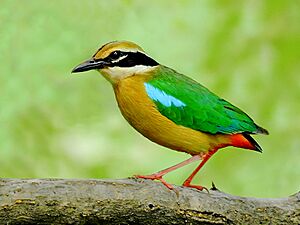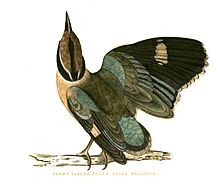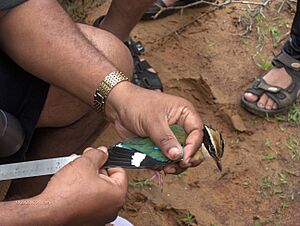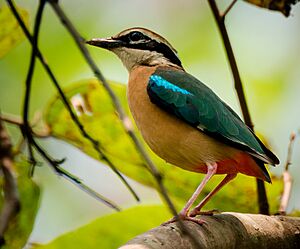Indian pitta facts for kids
Quick facts for kids Indian pitta |
|
|---|---|
 |
|
| Indian pitta in Maharashtra, India
|
|
| Conservation status | |
| Scientific classification | |
| Genus: |
Pitta
|
| Species: |
brachyura
|
| Synonyms | |
|
Corvus brachyurus Linnaeus, 1766 |
|
The Indian pitta (Pitta brachyura) is a beautiful, colorful bird that lives in the Indian subcontinent. Even though it has bright colors, it's often shy and hides in the bushes on the forest floor. It likes to pick up insects there for food. You can often hear its special two-note whistling call at sunrise and sunset. This bird is found in places like scrub jungles and different kinds of forests, including those with deciduous trees (which lose their leaves) and dense evergreen forests. It breeds in the forests of the Himalayas and the hills of central and western India. When winter comes, it flies to other parts of the peninsula. Scientists say there are many Indian pittas, so it is listed as a species of least concern on the IUCN Red List.
Contents
About Its Name
The Indian pitta got its scientific name from a famous Swedish scientist named Carl Linnaeus in 1766. Before that, people in England knew about it from drawings sent from India. The word 'pitta' comes from the Telugu language in India, and it means 'small bird'. The second part of its scientific name, brachyura, comes from old Greek words meaning 'short-tailed'. So, its name basically means 'short-tailed small bird'!
Local Names
In India, people have many different names for the Indian pitta. These names often describe its colors or when it calls. For example:
- In Hindi and Punjabi, it's called Naorang or Nauranga, which means 'Nine colors'. This is because of its many bright feathers!
- In Tamil, it's sometimes called Aru-mani kuruvi, which means '6-O'Clock bird'. This is because it often calls at dawn and dusk.
- In Sinhala, it's called Avichchiya. There's even a story that its call sounds like the bird complaining about a peacock stealing its dress!
What It Looks Like

The Indian pitta is a small bird with a short tail. It spends most of its time on the ground in forests, looking for insects among fallen leaves. It has strong, long legs and a short, strong beak.
Its feathers are very colorful:
- It has a buff (light yellowish-brown) stripe on its head.
- There are thick black stripes around its eyes.
- Its throat and neck are white.
- The top part of its body is green, and its tail is blue.
- The underside of its body is buff, with bright red feathers on its lower belly and under its tail.
This bird usually hops around on the ground when it's looking for food.
Its Call
You're more likely to hear an Indian pitta than to see one! It has a very clear and loud two-note whistle that sounds like wheeet-tieu or wieet-pyou. Sometimes, it even makes a three-note call. They also have a soft, single 'mewing' sound.
They often call once or twice at dawn or dusk, and sometimes other pittas nearby will join in. This is why it's called the "Six-O-Clock" bird in some places. When it calls, the bird throws its head back and points its beak upwards.
Where It Lives and Travels
The Indian pitta mostly breeds (has its babies) in the foothills of the Himalaya mountains, from northern Pakistan to Nepal and possibly up to Sikkim. It also breeds in the hills of central India and in the Western Ghats down to Karnataka.
When winter arrives, these birds fly to other parts of India and to Sri Lanka. Sometimes, tired birds might even show up in towns or villages. It's rare to find them in the Thar Desert.
Life and Habits
Indian pittas usually rest and sleep in trees. They eat insects and other small creatures without backbones, which they find on the ground or in piles of fallen leaves. They have even been seen eating food scraps from kitchens!
Reproduction and Life Cycle
Indian pittas breed during the south-west monsoon season, usually from June to August. In central India, they breed most in June, and in northern India, it's usually in July.
Their nest is shaped like a ball with a round opening on one side. They build it on the ground or on low branches using dry leaves and grasses. A female pitta usually lays four to five eggs. These eggs are very shiny, white, and round, with spots and speckles of dark red or purple.




